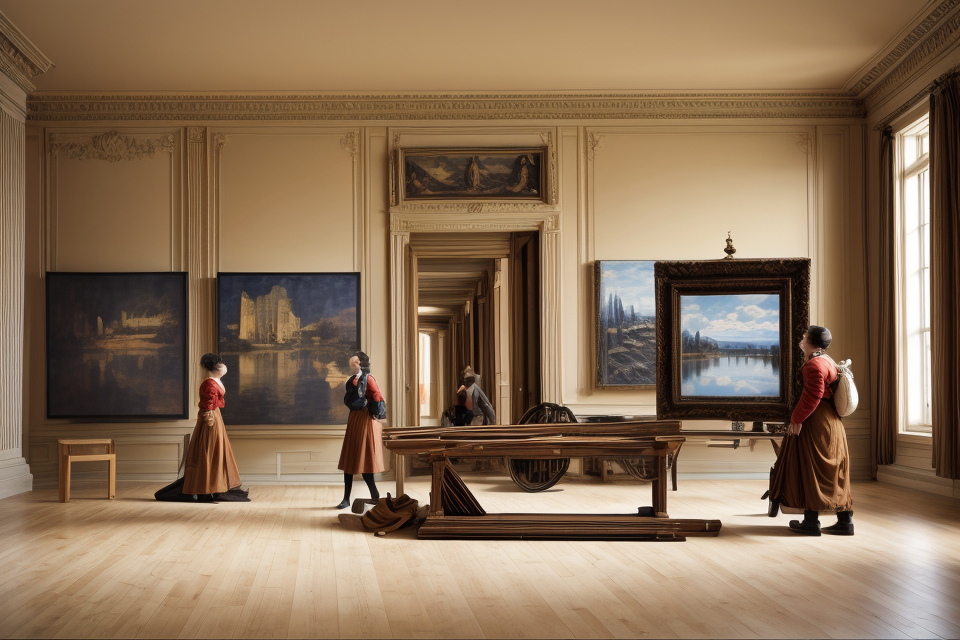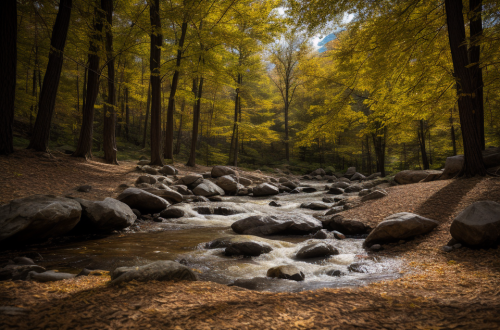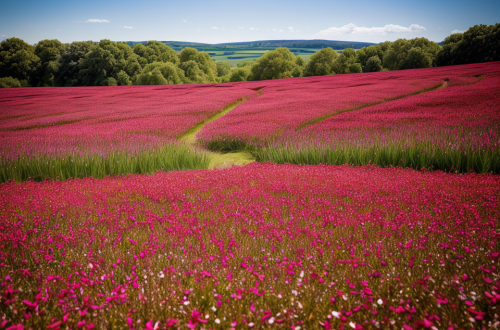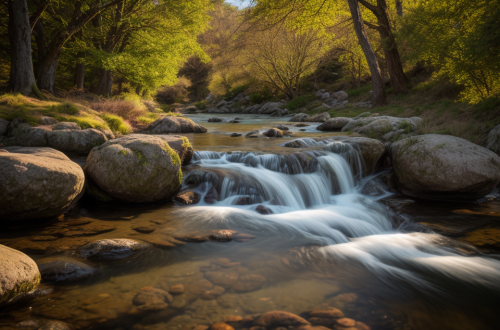Description:
In this article, we will explore the various composition techniques used in visual art, and how they can be applied to elevate your work. From the rule of thirds to leading lines, we will dive into the principles and practices that will help you create more dynamic and engaging compositions. Whether you’re a seasoned artist or just starting out, this guide will provide you with the tools and knowledge you need to take your art to the next level.
Composition techniques are the tools and methods used by artists to create a visual hierarchy in their artwork. These techniques help guide the viewer’s eye through the artwork, creating a sense of balance and harmony. By mastering composition techniques, artists can elevate their visual art and create pieces that are more impactful and engaging. In this guide, we will explore the most common composition techniques used in visual art, including the rule of thirds, leading lines, and negative space. We will also discuss how to apply these techniques to your own artwork and how to use them to tell a story or convey a message. So, whether you’re a seasoned artist or just starting out, this guide will help you master the art of composition and take your visual art to the next level.
Understanding Composition Techniques
The Importance of Composition in Visual Art
Composition is a vital aspect of visual art that cannot be overlooked. It is the arrangement of visual elements within a piece of art that creates a sense of balance, harmony, and visual interest. The way elements are arranged can greatly impact the overall effectiveness of a piece of art.
The role of composition in creating impactful art
Composition plays a crucial role in creating impactful art. It can make or break the overall impact of a piece. A well-composed piece of art will draw the viewer’s eye to the important elements and guide them through the artwork, creating a sense of movement and energy. On the other hand, a poorly composed piece of art will leave the viewer feeling confused and disinterested.
The difference between good and great compositions
Good compositions are effective in creating a sense of balance and harmony within a piece of art. They may have a clear focal point and use techniques such as leading lines and negative space to guide the viewer’s eye. However, great compositions go beyond these basics and use more advanced techniques to create a sense of depth, movement, and emotional impact. A great composition will engage the viewer on a deeper level and leave a lasting impression.
Common Composition Techniques
The rule of thirds
The rule of thirds is a fundamental principle in composition that involves dividing a visual frame into thirds, both horizontally and vertically. This creates a grid of nine equal parts, which can be used to position key elements of the image. Placing the main subject at one of the intersection points or along the gridlines can create a sense of balance and visual interest.
Symmetry and asymmetry
Symmetry and asymmetry are two concepts that refer to the arrangement of elements in a composition. Symmetry involves mirroring an object or group of objects along a central axis, creating a balanced and harmonious image. Asymmetry, on the other hand, is the lack of symmetry, creating a more dynamic and unpredictable composition. Asymmetry can be used to create tension and visual interest, while symmetry can be used to create a sense of calm and stability.
Leading lines
Leading lines are lines within an image that lead the viewer’s eye from one point to another. These lines can be used to guide the viewer’s gaze through the composition, creating a sense of depth and movement. Leading lines can be created by using natural elements such as roads, rivers, or paths, or by using man-made elements such as buildings, walls, or fences.
Negative space
Negative space is the empty space surrounding the main subject of an image. It is often used to create a sense of balance and harmony in a composition. Negative space can also be used to emphasize the main subject by drawing attention to it, while minimizing distractions and clutter. Using negative space effectively can create a sense of calm and simplicity in an image, while also providing a sense of depth and dimensionality.
Best Practices for Using Composition Techniques
When it comes to mastering composition techniques, there are several best practices that you should keep in mind. These practices will help you create more effective and impactful visual art. Here are some tips to consider:
Balancing elements in your composition
One of the most important aspects of composition is balance. You want to make sure that the elements in your composition are balanced in a way that creates a sense of harmony and stability. This can be achieved by using techniques such as symmetry, asymmetry, and the rule of thirds.
Experimenting with different techniques
Another best practice is to experiment with different composition techniques. Don’t be afraid to try new things and explore different approaches. This will help you develop your own unique style and voice as an artist.
Paying attention to the subject matter
Your subject matter is also an important consideration when it comes to composition. You want to make sure that the subject matter is the focal point of your artwork and that it is positioned in a way that highlights its importance.
Using composition to convey emotion and mood
Finally, composition can also be used to convey emotion and mood. By using techniques such as color, contrast, and texture, you can create a mood or atmosphere in your artwork that draws the viewer in and evokes an emotional response.
Overall, mastering composition techniques takes time and practice. By following these best practices, you can improve your skills and create more effective and impactful visual art.
Creating Dynamic Compositions
The Power of Diagonal Lines
Using diagonal lines to create movement and tension
Diagonal lines are a powerful tool for creating movement and tension in a composition. When used effectively, they can lead the viewer’s eye through the artwork, creating a sense of dynamism and energy. Here are some ways to use diagonal lines to create movement and tension in your compositions:
- Use diagonal lines to create a sense of movement: Diagonal lines can be used to create a sense of movement and action in a composition. For example, you can use diagonal lines to depict a moving figure or to show the movement of light or water.
- Use diagonal lines to create tension: Diagonal lines can also be used to create tension and conflict in a composition. For example, you can use diagonal lines to depict a tense or uneasy relationship between two figures or to show the tension between two opposing forces.
- Use diagonal lines to create a sense of depth: Diagonal lines can be used to create a sense of depth and dimensionality in a composition. For example, you can use diagonal lines to depict the recession of space or to show the different planes of a scene.
Examples of successful use of diagonal lines in art
There are many examples of successful use of diagonal lines in art. Here are a few examples:
- “The Persistence of Memory” by Salvador Dali: In this famous surrealist painting, Dali uses diagonal lines to create a sense of movement and tension. The melting clocks and the twisted landscape depicted in the painting all use diagonal lines to create a sense of unease and disorientation.
- “Nighthawks” by Edward Hopper: In this iconic painting, Hopper uses diagonal lines to create a sense of movement and action. The diagonal lines of the building and the streetlights lead the viewer’s eye through the composition, creating a sense of dynamism and energy.
- “The Scream” by Edvard Munch: In this famous painting, Munch uses diagonal lines to create a sense of tension and conflict. The diagonal lines of the figure and the landscape depicted in the painting all contribute to the sense of unease and anxiety conveyed by the painting.
The Impact of Color in Composition
Color plays a significant role in composition, as it can greatly influence the overall impact of a piece of art. Here are some ways in which color can influence composition:
- Creating Emotional Responses: Different colors can evoke different emotions in viewers. For example, warm colors like red and orange can create a sense of energy and excitement, while cool colors like blue and green can create a sense of calmness and tranquility. By strategically using certain colors, artists can manipulate the emotional response of their viewers.
- Directing the Eye: Color can also be used to direct the viewer’s eye through a composition. By using contrasting colors, an artist can create a visual path that leads the viewer’s eye through the piece. This can be particularly effective when combined with other composition techniques, such as leading lines or the rule of thirds.
- Creating Depth and Dimension: Color can also be used to create a sense of depth and dimension in a composition. By using shading and shadows, artists can create the illusion of three-dimensional space on a two-dimensional surface. This can make a composition feel more dynamic and lifelike.
- Balancing Elements: Finally, color can be used to balance elements within a composition. For example, if an artist is using a lot of dark colors in one area of the composition, they can balance it out by using lighter colors in another area. This can help create a sense of harmony and balance within the composition.
Overall, color is a powerful tool that can greatly influence the impact of a composition. By understanding how color can be used to create emotional responses, direct the viewer’s eye, create depth and dimension, and balance elements, artists can elevate their visual art to new heights.
The Role of Framing in Composition
Framing plays a crucial role in composition as it helps to define the boundaries of the artwork and direct the viewer’s attention towards the main subject. There are various framing techniques that can be used to enhance the composition of a visual art piece.
Framing techniques to enhance your composition
- Leading Lines: Leading lines are a framing technique that uses lines within the artwork to lead the viewer’s eye towards the main subject. This technique can be achieved by using natural or man-made elements such as roads, rivers, or walls.
- Symmetry: Symmetry is a framing technique that involves placing the main subject in the center of the artwork. This technique creates a sense of balance and harmony in the composition.
- Asymmetry: Asymmetry is the opposite of symmetry and involves placing the main subject off-center. This technique creates a sense of tension and movement in the composition.
- Depth of Field: Depth of field is a framing technique that uses the distance between the main subject and the background to create a sense of depth in the composition.
The importance of negative space in framing
Negative space is the empty space around the main subject in a composition. It is an essential element of framing as it creates a sense of balance and contrast in the composition. Negative space can also be used to draw the viewer’s eye towards the main subject by creating a sense of isolation or separation. It is important to use negative space effectively in order to create a dynamic and engaging composition.
Composition and Perspective
Understanding perspective in art is a crucial aspect of creating dynamic compositions. Perspective refers to the way objects appear to change in size and shape as they move further away from the viewer. There are two main types of perspective: one-point perspective and two-point perspective.
One-point perspective is the most common type of perspective used in art. It involves the use of a single vanishing point on the horizon line, which represents the convergence of all the parallel lines in the scene. To create a one-point perspective, the artist must establish a horizon line and then draw the other elements of the scene using lines that converge at the vanishing point.
Two-point perspective, on the other hand, involves the use of two vanishing points on the horizon line. This type of perspective is more complex than one-point perspective and is often used in architectural drawings or scenes with multiple converging lines.
Using perspective to create depth and dimension is an essential aspect of composition. By using perspective, artists can create a sense of depth and distance in their artwork, making it more dynamic and engaging for the viewer. For example, a road that recedes into the distance can create a sense of movement and depth, while a building with converging lines can create a sense of height and stability.
Additionally, perspective can be used to create a sense of volume and three-dimensionality in a two-dimensional artwork. By using shading and other techniques, artists can create the illusion of form and texture, making their artwork more lifelike and engaging.
In conclusion, understanding perspective in art is essential for creating dynamic compositions. By using one-point or two-point perspective, artists can create a sense of depth and distance in their artwork, making it more engaging and interesting for the viewer.
Putting it All Together
Creating a cohesive composition
Creating a cohesive composition is all about arranging the visual elements in a way that effectively communicates your message and draws the viewer’s eye to the important parts of the image. This can be achieved by considering the following:
- Balance: Distributing the visual weight of the elements in the image so that it feels stable and harmonious.
- Contrast: Using different values, colors, or textures to create visual interest and guide the viewer’s eye.
- Unity: Creating a sense of coherence by using consistent elements, such as color schemes or subject matter.
By paying attention to these key principles, you can create a composition that is not only visually appealing but also communicates your intended message effectively.
Tips for finalizing your composition
- Look for patterns and repetition in your image, and use them to reinforce your message or create a sense of unity.
- Consider the placement of your subject: is it central, off-center, or placed deliberately to draw the viewer’s eye?
- Use negative space to create breathing room in your composition and prevent it from feeling cluttered.
- Experiment with different cropping options to find the most dynamic and effective composition.
By following these tips, you can create a composition that is not only visually pleasing but also communicates your intended message effectively.
Recap of key concepts
- Emphasizing the importance of understanding the basics of design, such as balance, harmony, and proportion, in creating dynamic compositions.
- The use of contrast, whether it be color, value, or texture, to create interest and draw the viewer’s eye to specific areas of the composition.
- The use of the rule of thirds and the golden ratio to create visually pleasing arrangements of elements within the composition.
- The use of leading lines and diagonal lines to create a sense of movement and energy in the composition.
- The use of negative space to create a sense of calm and balance in the composition.
- The importance of experimenting with different composition techniques and finding what works best for your unique style and subject matter.
The importance of experimentation and practice
Experimentation and practice are essential components in mastering composition techniques. To create dynamic compositions, artists must be willing to try new approaches and push the boundaries of their creativity. Here are some reasons why experimentation and practice are crucial:
- Developing a unique style: By experimenting with different composition techniques, artists can develop their own unique style, which sets them apart from other artists.
- Improving technical skills: Practice allows artists to refine their technical skills, such as drawing, painting, or digital art. Technical proficiency is essential in creating dynamic compositions.
- Building confidence: As artists experiment and practice, they gain confidence in their abilities, which allows them to take risks and try new things.
- Overcoming creative blocks: Experimentation and practice can help artists overcome creative blocks, which can occur when they feel stuck in a rut or unable to come up with new ideas.
- Enhancing creativity: By trying new techniques and experimenting with different styles, artists can enhance their creativity and find new ways to express themselves.
In summary, experimentation and practice are crucial in mastering composition techniques. They allow artists to develop their unique style, improve their technical skills, build confidence, overcome creative blocks, and enhance their creativity.
Resources for further learning
- Books:
- “The Elements of Composition” by John R. Dilworth
- “Composition: A Creative Approach to Mastering the Art of Photography” by Richard S. Chalfen
- “Art & Fear: Observations on the Perils (and Rewards) of Artmaking” by David Bayles and Ted Orland
- Online Courses:
- Coursera: “Introduction to Digital Image and Video Processing”
- Udemy: “Composition Fundamentals for Photography and Art”
- Coursera: “Photography Basics and Beyond: From Smartphone to DSLR”
- Websites:
- The Art of Photography: A Complete Guide to Taking Stunning Photos
- Creative Flow: Tips for Improving Your Composition Skills
- Photography Life: Composition Techniques for Digital Photography
- Blogs:
- Sirui Tripod: The Ultimate Guide to Composition Techniques
- The Creative Process: Understanding Composition in Art
- The Photography Edit: 5 Tips for Better Composition
- Art Magazines:
- American Art Collector: Mastering Composition in Painting
- Artists & Illustrators: The Fundamentals of Composition
- The Artist: A Guide to Creative Composition
- YouTube Channels:
- The Art of Photography: Composition Techniques
- Practical Art: Understanding Composition in Art
- The Painting Podcast: Mastering Composition in Oil Painting
- Workshops and Classes:
- Local art schools and community centers
- Online workshops with professional artists
- Workshops at art conferences and conventions
- Social Media Groups:
- Facebook: Art Composition Discussion Group
- Instagram: #CompositionTips and #ArtComposition
- Twitter: #ArtComposition and #CompositionTips
These resources offer a wide range of information on composition techniques for visual art, including books, online courses, websites, blogs, art magazines, YouTube channels, workshops, and social media groups. By exploring these resources, artists can expand their knowledge and improve their composition skills, ultimately elevating their visual art.
FAQs
1. What are composition techniques used for in visual art?
Composition techniques are used in visual art to create a harmonious and visually appealing arrangement of elements within a piece. These techniques help artists to guide the viewer’s eye through the artwork and create a sense of balance and movement.
2. What are some common composition techniques used in visual art?
Some common composition techniques used in visual art include the rule of thirds, leading lines, symmetry, and negative space. These techniques can be used to create balance, depth, and interest in a piece.
3. How can I use composition techniques to improve my visual art?
To use composition techniques to improve your visual art, start by studying the basic principles of design, such as balance, contrast, and movement. Then, experiment with different techniques to see what works best for your style and subject matter. Practice, practice, practice! The more you use composition techniques, the more natural they will become, and the more your artwork will improve.
4. Is there a “right” way to use composition techniques in visual art?
There is no one “right” way to use composition techniques in visual art, as different techniques work best for different styles and subject matter. However, it’s important to understand the basic principles of design and how they relate to composition. Additionally, it’s important to experiment and find what works best for you and your art.
5. Can composition techniques be used in all types of visual art?
Composition techniques can be used in all types of visual art, including painting, drawing, photography, and printmaking. These techniques are useful for creating balance, depth, and interest in any type of artwork.
6. How can I learn more about composition techniques for visual art?
There are many resources available for learning about composition techniques for visual art, including books, online tutorials, and workshops. Additionally, you can study the work of other artists and analyze how they use composition techniques to create their artwork. Practice and experimentation are also key to mastering composition techniques.





